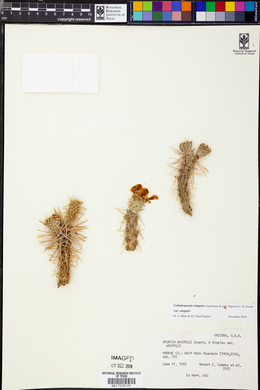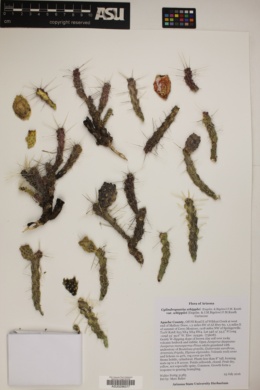Cylindropuntia whipplei
|
|
|
|
Family: Cactaceae
Rat-Tail Cholla, more...Whipple cholla, Whipple's cholla
[Cylindropuntia hualpaensis (Hester) Backeb., moreOpuntia whipplei Engelm. & Bigelow, Opuntia whipplei var. enodis Peebles, Opuntia whipplei var. whipplei Engelm. & J.M. Bigelow] |
Trees or shrubs, low to upright, sparingly to densely branched, some almost matlike in Arizona, 0.3-0.6(-1.5) m; branchlets whorled to subwhorled. Stem segments firmly attached, green, 3-9(-15) × 0.5-1.5(-2.2) cm; tubercles prominent, short, 0.5-1 cm; areoles oval to obdeltate, 2-6 × 1.5-4 mm; wool pale yellow to white, aging gray. Spines (1-)3-8(-10) spines per areole, in all but basalmost areoles, best developed toward apex, interlacing with spines of adjacent areoles, whitish or pale yellow, pale red-brown, sometimes tipped yellow, of 2 kinds; radial spines slender, flattened basally, deflexed, 5-8 mm, surrounding central spines; central spines usually 4(-6), spreading into a cross, stout, subterete, 2-3.4(-4.5) cm; also 0-2 bristlelike spines; sheaths whitish to pale yellow (rarely golden) throughout or tipped yellow to golden. Glochids in adaxial tuft, yellow, 1-3 mm. Flowers: inner tepals yellow to green-yellow, spatulate, 15-25(-30) mm, apiculate; filaments yellowish or yellow-green; anthers yellow; style white to yellowish; stigma lobes whitish, yellowish, or pale green (rarely pink tinged). Fruits rarely proliferating, yellow to greenish yellow, broadly cylindric to subspheric, 18-30(-35) × 15-22(-32) mm, fleshy, tuberculate, spineless; tubercles subequal or distalmost longest, usually prominent; umbilicus 7-8 mm deep; areoles 36-62. Seeds pale yellow, subcircular to slightly angular in outline, flattened to warped, 3-3.5 × 2.5-3.5 mm, sides smooth or with 1-3 depressions; girdle smooth. 2n = 22, 44. Flowering late spring-early summer (May-Jul). Desert and plains grasslands, juniper woodlands, oak, pinyon, or pine forests, sagebrush; 900-2300 m; Ariz., Colo., Nev., N.Mex., Utah. Cylindropuntia whipplei hybridizes with C. acanthocarpa in central Arizona; the hybrids [= C. ×congesta (Griffiths) F. M. Knuth (as species) (D. J. Pinkava 1999)] are compact shrubs with long-tuberculate stem segments 8-12 mm thick, bearing 0-4 erect or deflexed spines per areole, and tuberculate, green to yellowish fruits occasionally bearing one to few spines, and have chromosome number of 2n = 22. In areas of Arizona, Nevada, and Utah, C. whipplei hybridizes with C. echinocarpa, particularly with the low, compact form of C. echinocarpa; the hybrids [= C. ×multigeniculata (Clokey) Backeberg] have spineless to nearly spineless fruits, numerous intergrading spines per stem areole that are not dimorphic, and chromosome number of 2n = 22. Hybrids between C. whipplei and C. imbricata [= C. ×viridiflora (Britton & Rose) F. M. Knuth], which are found in scattered localities in northern New Mexico and northeastern Arizona, have a low, bushy habit, ripe cantaloupe-colored inner tepals, an irregular, monomorphic spine pattern, and a chromosome number of 2n = 22. Cylindropuntia ×media P. V. Heath, from the base of Wolf Creek Pass, Colorado (G. Arp 1973), reportedly has the same putative parentage as the older name C. ×viridiflora; further study of its parentage is warranted. Cylindropuntia whipplei also hybridizes with C. leptocaulis.
Plant: low to upright tree or shrub, sparingly to very densely branched with whorled to subwhorled branchlets, 0.5-1.3 m tall; STEM segments green, 3-9(-15) cm long, 0.5-1.5(-2.2) cm in diam.; tubercles very prominent and short, 5-10 mm long. AREOLES pale yellow- to white-felty, aging gray, oval to obdeltoid, 2-6 mm long, 1.5-4 mm wide Leaves: SPINES in all but basal-most areoles, best developed toward apex, whitish or pale yellow, pink pale red-brown, sometimes yellow-tipped, (1-)3-8(-10) per areole, interlacing, dimorphic per aerole, the sheaths whitish to pale yellow (rarely golden) throughout or yellow to golden tipped; central spines stout, subterete, usually 4(-6) spreading into a cross, 2-3.4(-4.5) cm long; lateral spines slender, flattened basally, deflexed, 5-8 mm long; also 0-2 bristly spines. GLOCHIDS yellow, in apical tuft, 1-3 mm long Flowers: inner tepals pale yellow, yellow to green-yellow, spatulate, apiculate 1.5-2.5(-3) cm long; filaments yellowish to yellow-green, the anthers yellow; styles white to yellowish; stigmas whitish, yellowish to pale green, rarely pink-tinged Fruit: yellow to greenish-yellow, pulpy-fleshy, broadly cylindric to subspheric, spineless, 18-30(-35) mm long, 15-22(-32) mm in diam., the tubercles sub-equal or uppermost longest, usually prominent, the umbilicus 7-8 mm deep; areoles 36-62. SEEDS 3-3.5 mm long, 2.5-3.5 mm wide, pale yellow, subcircular to slightly angular in outline, nearly flat to warped, the sides smooth or with 1-3 depressions, the girdle smooth Misc: Deserts, desert and plains grasslands, juniper woodlands with oaks, pinyons or sagebrush to pine forests, various substrates; 900-2300 m (2900-7600 ft); May-Jul REFERENCES: Pinkava, Donald J. 1999. Cactaceae. Ariz. - Nev. Acad. Sci. 32(1). Benson 1969, Benson 1982, FNA 2003, Pinkava 1999 Common Name: Whipple cholla Duration: Perennial Protected Status: Salvage restriced status in Arizona. Spines: Spines 4-14 per areole in all but basal areoles, best developed toward the apex and interlacing with spines of adjacent areoles. The central spines whitish or pale yellow to pale red-brown and sometimes tipped yellow, the radial spines slender and flattened basally but deflexed, 5-8 mm long and surrounding 4-6 central spines, these spreading into a cross and stout, subterete, usually 2-4.5 cm with 0-2 bristle-like spines. The sheaths whitish to pale yellow (rarely golden) throughout or tipped yellow to golden, the glochids in adaxial tuft are yellow and 1-3 mm. Flowers: Flowers 2-3 cm in diameter with yellow to green-yellow inner tepals, these spatulate and 6-9 mm long by 6-8 mm broad, the anthers yellow and style white to yellowish with stigma lobes that are whitish, yellowish, or pale green (rarely pink tinged). Fruits: Fruits rarely proliferating, yellow to greenish yellow and broadly cylindric to subspheric, 18-30 mm long by 15-22 mm in diameter, with a deep cuplike apical cavity that is fleshy and tuberculate along with being spineless. The tubercles are usually prom Ecology: Found in deep soils of valleys, plains, and gentle slopes of grasslands, woodlands, forests, and sagebrush from 4,500- 7,000 ft (1372-2134 m). Notes: Over much of its range C. whipplei is a low, mat-forming plant, but in other areas it is erect. In the rich valley bottoms of the Arizona strip it attains a height of 6-7 feet. The fruit and young branches are a favorite food of antelope. Ethnobotany: Used medicinally by the Hopi as an antidiarrheal, fruit eaten raw, stewed or dried for winter use, buds boiled and eaten, ceremonially used by the Navajo to make cactus prayer stick, Chiricahua Windway, and branches made into a wand and used in Red Antway. Etymology: Cylindropuntia is from Greek kylindros or a cylinder, plus the genus Opuntia, while whipplei is named for Lt. Amiel Weeks Whipple (1817-1863), a topographical engineer who commanded the Pacific Railroad Survey from Fort Smith, Arkansas to Los Angeles in 1853-1854 searching for a potential route for a transcontinental railroad. Synonyms: Opuntia whipplei Editor: LCrumbacher, 2010 |
|
|
|































































































